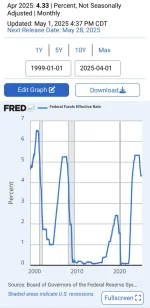I hope you are correct but I think the long-term big picture is not good:
"Delinquency rates on various consumer debts, including mortgages, auto loans, and credit cards, are rising. This trend indicates increasing financial stress among consumers, a factor that played a significant role in the previous financial crisis."
In the first quarter of 2025, total U.S.
consumer debt reached an all-time high of $18.2 trillion, according to the Federal Reserve Bank of New York's Quarterly Report on Household Debt and Credit. This is up from $17.68 trillion in February 2025. Mortgage debt, including home equity loans, accounted for $13.05 trillion, making up 73.8% of the total. Non-mortgage debt, including auto loans, student loans, and credit card balances, totaled $4.64 trillion.
The U.S. Department of Education today announced its Office of Federal Student Aid (FSA) will resume collections of its defaulted federal student loan portfolio on Monday, May 5th. The Department has
not collected on defaulted loans since March 2020. Total student loan debt in the U.S. is estimated to be $1.77 trillion, making it the second-largest consumer debt category after mortgages. Federal student loan debt makes up the vast majority, totaling $1.64 trillion.
- As of the first quarter of 2025, nearly 8% of total student debt was reported as 90 days past due, a significant increase from the previous quarter.
- Around 5.3 million borrowers are in default on their federal student loans.
- An additional 4 million borrowers are "late-stage delinquent," meaning they are more than 90 days behind on payments
For defaulted federal student loans, the U.S. Department of Education covers the losses, meaning taxpayers ultimately foot the bill.
Credit card balances
have risen by $412 billion since Q1 2021, when credit card debt bottomed out at $770 billion during the pandemic. That’s a 54% increase in four years. The average credit card interest rate is currently around 21.95%.
In early 2025,
auto loan delinquency rates have been on the rise, with subprime borrowers experiencing the
highest levels in decades. Specifically, as of January 2025,
Fitch Ratings reported that 6.56% of subprime auto borrowers were at least 60 days past due, the highest since they began collecting data in 1994. While prime borrowers are faring better, their 60-day delinquency rate also increased to 0.39% in January 2025, up from 0.35% in January 2024.
The estimate for U.S. real GDP for Q1 2025 is a contraction of -0.3% at an annualized rate. This marks the first negative quarterly reading since Q1 2022.
In 2025, the US debt to GDP ratio is projected to be around 122% of GDP. This means the total US debt is expected to be approximately $36.2 trillion, which is greater
than the country's GDP. The ratio is expected to continue rising in the coming years, with projections suggesting it could reach 124.40% by the end of 2025 and potentially 126.80% in 2026,
The Advisor Perspectives Buffett Indicator, which compares market capitalization to GDP, is currently at 209.6%, suggesting an overvalued market. Warren Buffett's Berkshire Hathaway held $334 billion in cash reserves at the end of 2024. This was a record high for the company.
In the first half of 2025, several major American companies have announced layoffs or workforce reductions, including Meta, Microsoft, Amazon, and Google. Other companies that have announced layoffs include Panasonic, Blue Origin, and Intel.
In 2025, the automotive industry is experiencing significant layoffs due to various factors including EV demand shifts, tariff impacts, and restructuring efforts. Several major automakers have announced plans to cut thousands of jobs, including General Motors, Ford, Stellantis, Nissan, Volkswagen, and Porsche."


